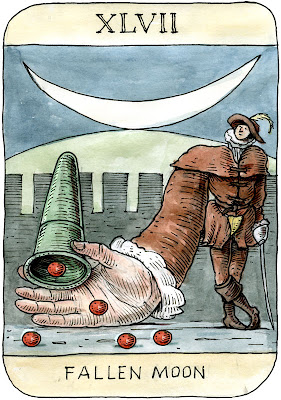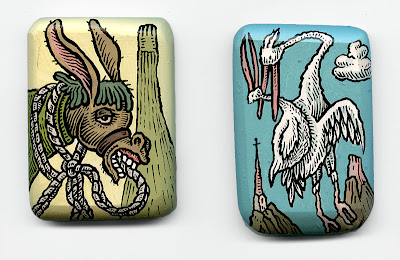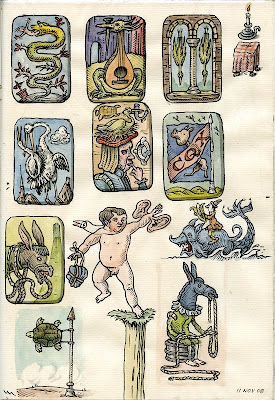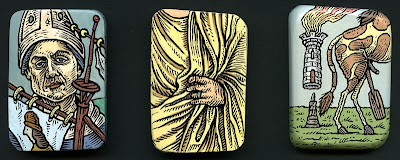
Pen and ink with watercolour 21cm x 15cm. Click to enlarge.
Viewing: Blog Posts Tagged with: Crisis, Most Recent at Top [Help]
Results 26 - 44 of 44
Blog: Ellis Nadler's Sketchbook (Login to Add to MyJacketFlap)
JacketFlap tags: man, people, watercolour, ink, words, pen, landscape, Nadler, hat, panels, hand, moon, castle, sword, planet, Add a tag
Blog: Ellis Nadler's Sketchbook (Login to Add to MyJacketFlap)
JacketFlap tags: animals, watercolour, ink, cloud, words, pen, Nadler, architecture, moon, castle, insect, Add a tag
 The Molar Beetle has gained a gold crown. Card III in my Tree of Life series. Be sure to collect all 10,000 cards.
The Molar Beetle has gained a gold crown. Card III in my Tree of Life series. Be sure to collect all 10,000 cards.
Pen and ink with watercolour 21cm x 15cm. Click to enlarge.
Blog: Time Machine, Three Trips: Where Would You Go? (Login to Add to MyJacketFlap)
JacketFlap tags: story, History, humour, Humor, battle, treasure, castle, Moral, Add a tag
My father told me a version of this strange tale when I was a child.
Many centuries ago, a green and fertile land became the scene of a conflict between two rulers - the White Count and the Black Count. Eventually the two counts lined up their opposing forces and fought a brief and bloody war from which the Black Count’s troops emerged victorious!
Safe in his tall, black tower, replete with the latest in crenellated wall features and dungeon accessories, the Black Count relished the war report from his trusty General.
“We overran the evil White Count’s forces my Lord, and they scattered in fear. The land is yours!” The General bowed low enough for the feathers in his iron helmet to sweep the ground at his master’s feet.
“Excellent.” The Black Count smiled with satisfaction, leaned back in his throne and pressed his hands together. Then, looking over the tips of his fingers, he regarded the General with narrowed eyes. “But what of the White Count, and all of his treasure? I do not see his head on a spike. I do not see bearers bringing chests of jewels and gold. What of these things?”
The General cleared his throat, glancing around the throne room with nervous eyes. Once more he bowed very low to the ground.
“My Lord, the White Count retreated to his white castle and remains there. His treasures are hidden and nobody knows the secret of their whereabouts.”
The Black Count leaped to his feet with barely suppressed fury. Gesturing wildly, he bellowed commands at his general, his servants and anyone else within earshot. One by one his soldiers and courtiers hurried to their appointed tasks.
I will not bore you with the story of how the Black Count’s army marched to the fortress of the White Castle, nor how they laid seige to it and gave battle until at last the White Count was captured in disgrace. Suffice it to say that before much time had passed, the White Count found himself on his knees at the Black Castle with an executioner’s tool at his neck and the Black Count standing over him in victory.
“Tell me the secret. Tell me where your gold and jewels are hidden,” demanded the Black Count, “or you will feel the axe at your neck.”
“I will never tell,” replied the White Count proudly.
Three more times the Black Count asked his question, and three more times he received the same answer. At last, frustrated, he gave up all hope of uncovering the whereabouts of the White Count’s riches and ordered the executioner to swing his axe and separate his adversary’s head from his body.
The watching crowd held its collective breath as the black-hooded executioner raised his axe high up into the air.
Suddenly, the White Count let out a cry.
“Wait! I’ll tell you. It’s . . . “
But it was too late. The axe fell with a thud and the White Count’s head rolled across the ground, landing at the feet of his enemy. He took the secret of his hidden treasure to the grave.
And the moral of the story is: you should never hatchet your Counts before they chicken.
Blog: Time Machine, Three Trips: Where Would You Go? (Login to Add to MyJacketFlap)
JacketFlap tags: History, humour, Humor, battle, treasure, castle, Moral, story, Add a tag
My father told me a version of this strange tale when I was a child.
Many centuries ago, a green and fertile land became the scene of a conflict between two rulers - the White Count and the Black Count. Eventually the two counts lined up their opposing forces and fought a brief and bloody war from which the Black Count’s troops emerged victorious!
Safe in his tall, black tower, replete with the latest in crenellated wall features and dungeon accessories, the Black Count relished the war report from his trusty General.
“We overran the evil White Count’s forces my Lord, and they scattered in fear. The land is yours!” The General bowed low enough for the feathers in his iron helmet to sweep the ground at his master’s feet.
“Excellent.” The Black Count smiled with satisfaction, leaned back in his throne and pressed his hands together. Then, looking over the tips of his fingers, he regarded the General with narrowed eyes. “But what of the White Count, and all of his treasure? I do not see his head on a spike. I do not see bearers bringing chests of jewels and gold. What of these things?”
The General cleared his throat, glancing around the throne room with nervous eyes. Once more he bowed very low to the ground.
“My Lord, the White Count retreated to his white castle and remains there. His treasures are hidden and nobody knows the secret of their whereabouts.”
The Black Count leaped to his feet with barely suppressed fury. Gesturing wildly, he bellowed commands at his general, his servants and anyone else within earshot. One by one his soldiers and courtiers hurried to their appointed tasks.
I will not bore you with the story of how the Black Count’s army marched to the fortress of the White Castle, nor how they laid seige to it and gave battle until at last the White Count was captured in disgrace. Suffice it to say that before much time had passed, the White Count found himself on his knees at the Black Castle with an executioner’s tool at his neck and the Black Count standing over him in victory.
“Tell me the secret. Tell me where your gold and jewels are hidden,” demanded the Black Count, “or you will feel the axe at your neck.”
“I will never tell,” replied the White Count proudly.
Three more times the Black Count asked his question, and three more times he received the same answer. At last, frustrated, he gave up all hope of uncovering the whereabouts of the White Count’s riches and ordered the executioner to swing his axe and separate his adversary’s head from his body.
The watching crowd held its collective breath as the black-hooded executioner raised his axe high up into the air.
Suddenly, the White Count let out a cry.
“Wait! I’ll tell you. It’s . . . “
But it was too late. The axe fell with a thud and the White Count’s head rolled across the ground, landing at the feet of his enemy. He took the secret of his hidden treasure to the grave.
And the moral of the story is: you should never hatchet your Counts before they chicken.
Add a CommentBlog: Ellis Nadler's Sketchbook (Login to Add to MyJacketFlap)
JacketFlap tags: dog, animals, cartoon, watercolour, paint, cloud, eye, Nadler, hat, architecture, castle, helmet, nose, brush, chimney, Add a tag
 The Bishop of Dog.
The Bishop of Dog.
Watercolour A5 size. Click to enlarge.
Blog: Ellis Nadler's Sketchbook (Login to Add to MyJacketFlap)
JacketFlap tags: man, war, religion, people, car, watercolour, ink, cloud, pen, death, Nadler, hat, sculpture, castle, wheels, transport, helmet, bridge, chimney, plane, Add a tag
 A meeting of the brigade chaplains following the failed thrust on the southern front.
A meeting of the brigade chaplains following the failed thrust on the southern front.
Pen and ink with watercolour. 17.5cm x 12.5cm. Click to enlarge.
Blog: Ginger Pixels (Login to Add to MyJacketFlap)
JacketFlap tags: dragon, Ginger Nielson, Winston the Wonderhound, castle, queen, Add a tag
Upon entering the castle the cook took Winston and Roxxanne directly to the huge kitchen...the scene of the crime.
Pieces of golden china and fragile crystal were strewn across the marbled floor.
"Oh how terrible," Roxxanne was shaken by the horrible destruction.
"Yes," added Winston, "terrible indeed!"
"TERRIBLE YOU SAY!!!!! TERRIBLE INDEED~" a shrill yet booming voice echoed through the great expanse of the kitchen.
There in front of the tragic trio stood the Queen. Queen Mellameen, to be exact, and she was not in a good mood.
"What in the BIG WIDE WORLD of my PERSONAL QUEENDOM happened here?" she demanded.
"Oh, your majesty, " stammered the cook, " I am so sorry about all this mess." She took a deep breath and began to explain to the queen how the huge beast (dragon) had burst into the kitchen while she was preparing the Queen's birthday dinner, and had gobbled up all the fine china and crystal.
"And, your Majesty, I am sorry to say he has also eaten your beautiful soup tureen, ladle and all."
"What???? YOU'VE LOST MY ROYAL GOLDEN BOWL? Surely for this your head will roll!"
As you can see the queen did not take the news lightly and as Winston and Roxxanne and the cook stood shuddering at this last exclamation from the angry monarch, another more terrifying noise was heard.
©Ginger Nielson- all rights reserved
(Stay tuned kiddies,...... and if you want to see previous chapters, just scroll down in the blog for any Wednesday. OR check the Wowzio panel to the right of this post and see the other chapters as a thumbnail.)
Blog: Ginger Pixels (Login to Add to MyJacketFlap)
JacketFlap tags: children, dragon, Ginger Nielson, Winston the Wonderhound, castle, children's story, queen, Add a tag

Having been Bumped right out of the moat, Winston and Roxxanne found themselves directly in front of a tearful young lady. Although they were already dripping wet, her tears threatened to keep them from drying off at all.
 Working sketch for this segment.
Working sketch for this segment.
Blog: Monday Artday (Login to Add to MyJacketFlap)
JacketFlap tags: valentine, red, blue, castle, sea, lover, couple, tilen.dawanda.com, Add a tag

Trying to achieve acrylic feel with ArtRage.
**tilen-artplanet.blogspot.com**
Blog: Ellis Nadler's Sketchbook (Login to Add to MyJacketFlap)
JacketFlap tags: food, animals, mythology, ink, volcano, cloud, bird, pen, mouth, Nadler, panels, castle, clay, Add a tag
 Two more clay tablets.
Two more clay tablets.
Polymer clay,acrylic paint and ink. Approx. 35mm x 50mm each.
Blog: Ellis Nadler's Sketchbook (Login to Add to MyJacketFlap)
JacketFlap tags: children, music, animals, mythology, people, watercolour, ink, bird, pen, landscape, mouth, Nadler, snake, fish, hat, panels, architecture, hand, castle, nude, Add a tag
 The time has come to eliminate the letters C, Q and X from the English alphabet, once and for all.
The time has come to eliminate the letters C, Q and X from the English alphabet, once and for all.
Ink and watercolour. 25cm x 17cm. Click to enlarge.
Blog: Ellis Nadler's Sketchbook (Login to Add to MyJacketFlap)
JacketFlap tags: religion, animals, people, acrylic, ink, paint, pen, Nadler, boat, hat, panels, hand, castle, fire, clay, Add a tag
 Three more tiles for my new board game "The Papal Giraffe", which should be in the shops by Christmas.
Three more tiles for my new board game "The Papal Giraffe", which should be in the shops by Christmas.
Polymer clay with acrylics and ink. Each tile approx 55mm x 38mm. Click to enlarge.
Blog: Plot Whisperer for Writers and Readers (Login to Add to MyJacketFlap)
JacketFlap tags: antagonists, Crisis, protagonist, Crisis, protagonist, antagonists, Add a tag
Think of the CRISIS, which generally occurs around 3/4 into the entire project, as the ANTAGONIST'S CLIMAX, or where the antagonists prevail.
OR
The CRISIS is the PROTAGONIST'S moment of truth, where afterwards nothing is ever the same.
OR
In the CRISIS, the PROTAGONIST has a breakdown that leads to a break through.
Blog: Plot Whisperer for Writers and Readers (Login to Add to MyJacketFlap)
JacketFlap tags: Dramatic Action, Crisis, PLot Planner, Character emotional devleopment, scene tracker template Climax, Crisis, Dramatic Action, scene tracker template Climax, PLot Planner, Character emotional devleopment, Add a tag
PLOT Q & A
Q: How do you specifically track emotional development within the plot planner?
A: Using the Plot Planner template, plot the scenes in the Beginning ¼ of your project either above or below the line, depending on if the character is in control (above the line) or an antagonist of some sort holds the power (below the line). Note the aspects of the Character Emotional Development (CED) introduced as is now ~~ flaws, fears, secrets and all. Use a different color from the notes you write for the Dramatic Action (DA) plot line.
For example, in Folly by Laurie R. King, the protagonist is introduced as fragile, doubtful, exhausted, and fearful upon her arrival at the island. In one color, write “arrival” to note DA. In another color, write “fragile and fearful” to indicate the CED at this point.
Feeling fragile and fearful and on the edge is not a temporary emotional state (the temporary emotions belong under the “Change” column of the Scene Tracker). Feeling fragile and fearful and on the edge is where she is in her overall lifetime emotional development due to what has come before (the backstory).
The Middle section shows scenes above or below the Plot Planner line that show how the character's current emotional development affects her life on a deeper level. In the Middle, the shorthand for her emotional development usually shows how her internal antagonists ~~ her fears, flaws and secrets ~~ sabotage her from reaching her goals.
In Folly, the Crisis ~~ the scene of most intensity in the story so far ~~ the protagonist is on the brink of a full-blown breakdown. This serves as a wake-up call, a moment of no return. She now understands the extent of her fragility, but she is also given a glimpse into who she could be with focused and conscious effort.
The End shows her CED in terms of the degree to which she keeps control as she works her way to mastery. The moment of true mastery is shown in the Climax.
In essence, each set of notes in the color for CED should show a visual pattern of the CED arc.
Q: On page 156 under the PLOT PLANNER section, you mention on finding a scene where the character emotional development is at its peak. Using your scene tracker tool, how would I go about finding one?
A: Divide all the scenes on your Scene Tracker and divide by ¾. Around that mark, look for the scene where the emotional stakes are at their highest.
Q: Within the PLOT PLANNER section of your book, you have a chapter on plotting the Thematic significance. I see how it is being done through scene tracker, but how is it being plotted on the plot line so that a visual representation of the theme is seen on the plot line? I take it that was your purpose for this section and not to revert back to scene tracker? I’m a little confused as I am taking it for granted that Plot Planner and Scene Tracker should be two separate tools.
A: Yes, the Plot Planner allows you to see the different plot threads as they interplay together throughout the project. By plotting the scenes above or below the line and indicating the three plot line elements, each in a different color, a writer is able to see the ebb and flow of their scenes at the overall story level.
The Scene Tracker is meant as a way to see how the different plot threads work together within each scene.
Q:I'm confused about the definition of "scene" in the first and second halves of the book. In the first half, I was instructed not to include summaries as scenes, but in the second half (the plot planner), it says that scenes that go "below the line" include summaries. I'd already weeded out the summaries from my scene list, and now I'm confused.
A: Some of the information you may want to keep track of on your Plot Planner sometimes comes in the form of summary. Scene, however, is where the story unfolds.
Blog: Plot Whisperer for Writers and Readers (Login to Add to MyJacketFlap)
JacketFlap tags: The End, The Middle, The Beginning, Crisis, Climax, Readers, Crisis, The End, Climax, The Middle, The Beginning, Add a tag
We as writers may start out writing just for ourselves, but even for those who are the most resistant to admit it, we each long for a readership to enjoy our projects.
Once a writer embraces that truth, our relationship to our writing changes.
One way to consider your readers or audience is to get closer to yourself. What kinds of writing do you like? How does your favorite author begin their stories? In scene or in summary? How do your scenes compare to theirs in terms of complexity, interest, excitement, character development, and truth?
What constitutes the Beginning, the Middle and the End of their projects? Can you detect what launches the character(s) into the heart of the story world towards the end of the Beginning? Does the Crisis reveal anything about the character to the his or herself or does the highest point in the story so far function only on the Dramatic Action level alone? How does the Climax show the character doing something they could not have done at the beginning of the story? Is there Thematic Significance to their writing? Is there to yours?
One of the greatest personal benefits of writing is the opportunity to dig deep for our own individual truth. The first draft for many writers skims the surface as we look for meaning and conflict shown in scene and how the characters will show their transformatio over time. Often, what we write in these first drafts is what we've heard before or learned from our family and friends, in school, and through our own reading and the news.
But once we read what we have written, we immediately sense when something does not ring true. There is no better way to learn what is true for us and what is not, than to read our words ourselves first.
As I stated in my plot book for writers, Blockbuster Plots Pure & Simple, my hope for you and for me is that our search for the truth through our writing remains active and honored. We dig for the truth not only for ourselves, but for our future audience as well.
We each share the need to be heard.
We each have something vital to offer.
Blog: Plot Whisperer for Writers and Readers (Login to Add to MyJacketFlap)
JacketFlap tags: Dramatic Action, Crisis, Climax, Character, Crisis, Dramatic Action, Climax, Add a tag
Readers turn the pages based on their interest in the characters or the excitement caused by the dramatic action or both. The Middle goes on for quite awhile (1/2 of the entire project), and sure, there is lots of conflict, tension, suspense to keep the reader reading, but all those scenes are building to something and that something is the payoff ~~ the Crisis (about 3/4 of the way through the entire book).
It's like climbing a hill. We keep hiking for lots of different reasons, but in the end we're hoping to get to the top = the payoff. In the case of a story, the Crisis is getting to the top. Except, the reader and the character reaches the top only to realize they're only part way there, that another peak awaits them ~~ the Climax ~~ the ulimate payoff for the reader, the crowning glory of the entire project.
Analyzing other books similar to your genre helps writers begin to "feel" the energetic flow of the story and better helps you apply the principles to your own work. Plus, you'll find lots of great hints and tips and ideas when you are reading as a writer, not just a reader.
Blog: OUPblog (Login to Add to MyJacketFlap)
JacketFlap tags: Book, God, Religion, Politics, Current Events, Excerpt, Europe, A-Featured, Jenkins, Crisis, World History, Western Religion, Philip, Muslim, Islam, Christianity, Add a tag
Yesterday we posted a Q and A with Philip Jenkins author of God’s Continent: Christianity, Islam, and Europe’s Religious Crisis. Below is an excerpt from the first chapter Jenkins’s new book. Check it out below.
Your Religion Tomorrow
If Europe were a woman, her biological clock would be rapidly running down. It is not too late to adopt more children, but they won’t look like her.- Philip Longman
Blog: OUPblog (Login to Add to MyJacketFlap)
JacketFlap tags: God, Religion, Politics, Europe, A-Featured, Jenkins, Crisis, Christian, World History, Western Religion, Philip, Muslim, Islam, Continent, Add a tag
Philip Jenkins is Distinguished Professor of History and Religious Studies at Penn State University as well as the author of numerous books. His most recent title, God’s Continent: Christianity, Islam, and Europe’s Religious Crisis, offers a measured assessment of Europe’s religious future. Below Jenkins was kind enough to answer some questions for OUP.
OUP: This is the final book in your series on the future of Christianity, how does it differ from the other titles? (more…)
Blog: OUPblog (Login to Add to MyJacketFlap)
JacketFlap tags: Law, lessons, Business, Blogs, Current Events, Philosophy, Media, eagleton, dispatches, versus, america’s, crisis, forgotten, violence, Add a tag
There are so many great posts showing up in my bloglines today I had to share some of them! Check these tidbits out.
Dispatches: Eagleton versus Dawkins.
Forgotten Lessons from America’s First Gun Violence Crisis.
An intelligent look at gambling in Second Life.
Help save the AJC book section.



It is said that they spread the plague around medieval Europe by seeping infected dentine from their cavities. Who says it? Not me, but it is a tale told by dentists and the feeble-minded.
10,000 cards?... then I better get started collecting.
Well, I've got the first 2...
Another fucking must-do to add to me infinite list.
John, Paul, George, Ringo and Molar.